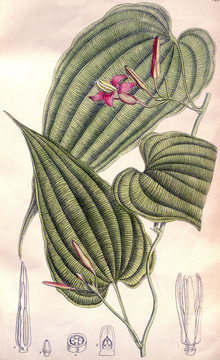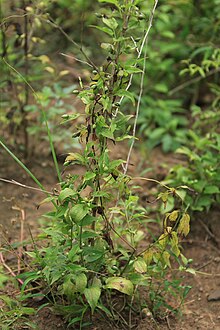Stemona
| Stemona | |
|---|---|

| |
| Stemona curtisii[1] | |

| |
| Stemona japonica | |
| Scientific classification | |
| Kingdom: | Plantae |
| Clade: | Tracheophytes |
| Clade: | Angiosperms |
| Clade: | Monocots |
| Order: | Pandanales |
| Family: | Stemonaceae |
| Genus: | Stemona Lour. |
| Synonyms[2] | |
| |
Stemona is a genus of vines and subshrubs in the family Stemonaceae, described as a genus in 1790.[3][4]
Stemona is native to China, the Indian Subcontinent, Southeast Asia, Papuasia, and northern Australia.[2][5]
Species[edit]
- S. angusta I.Telford - Qld
- S. aphylla Craib - Thailand
- S. australiana (Benth.) C.H.Wright NG, NT, WA, Qld
- S. burkillii Prain - Thailand, Myanmar
- S. cochinchinensis Gagnep. - Vietnam
- S. collinsiae Craib - Thailand, Vietnam
- S. curtisii Hook.f. - Sri Lanka, Nicobar, Thailand, Lepar
- S. griffithiana Kurz - Myanmar
- S. hutanguriana Chuakul - Thailand
- S. involuta Inthachub - Thailand
- S. japonica (Blume) Miquel - SE China, Japan
- S. javanica (Kunth) Engl. - Java, Maluku, Bismarck, NG
- S. kerrii Craib - Yunnan, Thailand, Vietnam
- S. kurzii Prain - Myanmar
- S. lucida (R.Br.) Duyfjes - Qld, NG, Philippines
- S. mairei (H.Léveillé) K.Krause - Sichuan, Yunnan
- S. parviflora C.H.Wright - Hainan
- S. phyllantha Gagnep. - Thailand
- S. pierrei Gagnep. - Vietnam, Laos
- S. prostrata I.Telford - NT
- S. temona rupestris Inthachub - Thailand
- S. sessilifolia (Miq.) Miq. - SE China
- S. squamigera Gagnep. - Laos
- S. tuberosa Lour. - China, Indian Subcontinent, SE Asia, New Guinea
Fossil record[edit]
2 fossil seeds of †Stemona germanica from the early Miocene, have been found in the Kristina Mine at Hrádek nad Nisou in North Bohemia, the Czech Republic. Fossil seeds of Stemona germanica have also been recorded from the nearby Hartau in Germany. Stemona fossil seeds are recorded from many European sites ranging in ages from the Maastrichtian to the Late Miocene.[6]
Cultivation and uses[edit]
Stemona tuberosa (Chinese: 百部; pinyin: bǎi bù), is one of the 50 fundamental herbs used in traditional Chinese medicine.
Stemofoline alkaloids occur in the stems and leaves of Stemona species, particularly S. japonica and have been investigated for use as pharmacological and pesticidal compounds.[7][8][9] The chemical structure of the insecticide flupyradifurone was inspired by stemofoline.[10]
References[edit]
- ^ 1892 illustration by J.N. Fitch (d. 1927) - Curtis's Botanical Magazine v.118 [ser. 3:v.48] (1892)
- ^ a b Kew World Checklist of Selected Plant Families
- ^ Loureiro, João de. 1790. Flora cochinchinensis : sistens plantas in regno Cochinchina nascentes. Quibus accedunt aliae observatae in Sinensi imperio, Africa Orientali, Indiaeque locis variis. Omnes dispositae secundum systema sexuale Linnaeanum 2: 401, 404 in Latin
- ^ Tropicos, Stemona Lour.
- ^ Flora of China Vol. 24 Page 70 百部属 bai bu shu Stemona Loureiro, Fl. Cochinch. 2: 401, 404. 1790.
- ^ A review of the early Miocene Mastixioid flora of the Kristina Mine at Hrádek nad Nisou in North Bohemia, The Czech Republic, January 2012 by F. Holý, Z. Kvaček and Vasilis Teodoridis - ACTA MUSEI NATIONALIS PRAGAE Series B – Historia Naturalis • vol. 68 • 2012 • no. 3–4 • pp. 53–118
- ^ Yamamoto, Izuru; Casida, John E., eds. (1999). Nicotinoid Insecticides and the Nicotinic Acetylcholine Receptor. p. 46. doi:10.1007/978-4-431-67933-2. ISBN 978-4-431-68011-6. S2CID 34374399.
- ^ Tang, Chun-Ping; Chen, Tong; Velten, Robert; Jeschke, Peter; Ebbinghaus-Kintscher, Ulrich; Geibel, Sven; Ye, Yang (1 January 2008). "Alkaloids from Stems and Leaves of Stemona japonica and Their Insecticidal Activities". Journal of Natural Products. 71 (1): 112–116. doi:10.1021/np070427k.
- ^ Huang, Xiong-Zhi; Gao, Long-Hui; Huang, Pei-Qiang (20 October 2020). "Enantioselective total syntheses of (+)-stemofoline and three congeners based on a biogenetic hypothesis". Nature Communications. 11 (1). doi:10.1038/s41467-020-19163-4. PMC 7576163.
- ^ Nauen, Ralf; Jeschke, Peter; Velten, Robert; Beck, Michael E.; Ebbinghaus-Kintscher, Ulrich; Thielert, Wolfgang; Wölfel, Katharina; Haas, Matthias; Kunz, Klaus; Raupach, Georg (2015). "Flupyradifurone: a brief profile of a new butenolide insecticide". Pest Management Science. 71 (6): 850–862. doi:10.1002/ps.3932. ISSN 1526-4998. PMC 4657471. PMID 25351824.
External links[edit]
- "Stemona Lour". Australian Plant Name Index (APNI), IBIS database. Centre for Plant Biodiversity Research, Australian Government.
- Germplasm Resources Information Network: Stemona
